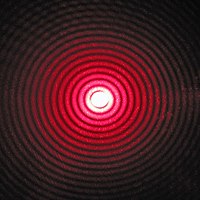
Photo from wikipedia
Bragg coherent diffraction imaging (BCDI) provides a powerful tool for obtaining high-resolution structural information from nanocrystalline materials. Here a BCDI sample consisting of a large number of randomly oriented nanoscale… Click to show full abstract
Bragg coherent diffraction imaging (BCDI) provides a powerful tool for obtaining high-resolution structural information from nanocrystalline materials. Here a BCDI sample consisting of a large number of randomly oriented nanoscale crystals is considered. Ideally, only one crystal is oriented to produce a Bragg peak on the detector. However, diffraction from other crystals often produces additional signals on the detector. Before the measured diffraction patterns can be processed into structural images, scientists routinely need to manually identify and remove the `alien' intensities from sources other than the intended crystal. With the development of modern high-coherence storage rings, such as the upgraded Advanced Photon Source (APS), the already slow process of manual preprocessing will be untenable for the large volumes of data that will be produced. An automated method of identifying and deleting alien intensities is proposed. This method exploits the fact that BCDI of a perfect crystal produces diffraction data with inversion symmetry around the Bragg peak. This approach uses the machine learning clustering method DBSCAN to distinguish between diffraction from multiple sources, and then calculates cluster size and inversion symmetry to assess whether clusters of intensity belong to desired data or alien signals. This approach can dramatically reduce the amount of time spent manually processing data, allowing BCDI data processing capabilities to keep pace with the technological advances of fourth-generation synchrotron light sources.
Journal Title: Journal of Applied Crystallography
Year Published: 2021
Link to full text (if available)
Share on Social Media: Sign Up to like & get
recommendations!